Ikeda Sensei joined the Soka Gakkai on Aug. 24, 1947, 75 years ago this month. In the following essay excerpt, Ikeda Sensei describes his first Soka Gakkai meeting and how encountering his mentor, Josei Toda, became the starting point for his lifelong struggle for peace. This essay originally appeared in the Aug. 24, 2011, Seikyo Shimbun, the Soka Gakkai’s daily newspaper.
In the summer month of August 1947, two years after Japan’s defeat in World War II, I attended a discussion meeting in Tokyo’s Ota Ward, large tracts of which were still burned-out ruins. It was there that I met Josei Toda, who would become my eternal mentor.
“How old are you now?” he asked me. “I am 19,” I said.
Though it was our first encounter, he addressed me as if we were old acquaintances.
Actually, Mr. Toda had already heard about me sometime earlier from my friends who were local members. He knew that my eldest brother had been killed in the war, that my family’s home had been destroyed in the wartime bombing and that I was studying while trying to support my parents.
I fondly remember with deep gratitude those individuals who spoke to Mr. Toda about me. Now, whenever I hear good news about a member sharing Nichiren Buddhism with someone, I think of their earnest prayers and dedication, as well as the sincerity of everyone else involved in enabling the new person to begin practicing.
On Aug. 24, 1947—a Sunday, 10 days after my initial meeting with Mr. Toda—I joined the Soka Gakkai. Looking at my diary from that time, it was a very hot day, reaching around 96 degrees. The gongyo ceremony, which was then very long, proceeded at a slow pace, and it was excruciating to remain seated on my knees in the traditional Japanese style for such a length of time. I still vividly remember that painful experience even now.
Nevertheless, I set forth on the path of faith, trusting Mr. Toda’s character.
It was a tumultuous time in Japan. An article in the morning newspaper the following day reported the sobering results of a survey, which found that 90% of families couldn’t make ends meet on their earnings alone. Two months later, the nation was shocked by the news that an upstanding judge at the Tokyo District Court had died of starvation, because he had strictly abided by food rationing and refused to eat anything purchased from black market sources. The country was also hit by a string of natural disasters—earthquakes, typhoons and the volcanic eruption of Mount Asama.
On the international scene, Cold War tensions were on the rise, and the threat of nuclear war seemed imminent.
Mr. Toda was giving a lecture on the Daishonin’s treatise “On Establishing the Correct Teaching for the Peace of the Land” at that first discussion meeting I attended. Just as he emphasized on that occasion, though still few in number, we, the members of the Soka Gakkai, walking the path of the oneness of mentor and disciple, were raising high the banner of the correct teaching of Buddhism in order to illuminate and dispel the darkness of Japan’s postwar chaos and confusion. …
Mr. Toda declared: “What matters most about a person are their principles and their actions. That’s why Soka Gakkai youth, who uphold the world’s supreme philosophy and are taking action for the happiness of others, should always have the courage, self-confidence and conviction to talk to anybody about their beliefs.”
The struggle to establish the correct teaching for the peace of the land that I embarked upon from that Aug. 24, when I was 19 years old, became the purpose of my youth and my entire life.
Read the two-part essay in the Oct. 14 and 21, 2011, editions of the World Tribune, pp. 4–5.
You are reading {{ meterCount }} of {{ meterMax }} free premium articles

